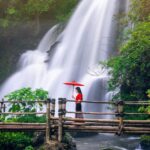Looking for the best time to visit Japan, a country where warm hearts overshadow energy. With seasonal changes, the Land of the Rising Sun offers travellers a memorable experience all year round. In spring, the stunning sight of cherry blossoms draws crowds to parks and festivals, creating lively celebrations of nature’s beauty. Summer comes alive with vibrant traditional festivals that fill the streets, showcasing Japan’s rich cultural heritage amidst warm weather.
Autumn features breathtaking fall foliage that paints the landscapes in brilliant colours, making it perfect for outdoor adventures. In winter, Japan transforms into a snowy paradise, perfect for skiing and relaxing in cosy hot springs. Each season offers unique sights, ensuring every traveller can find joy in the Land of the Rising Sun, making Japan a diverse destination throughout the year. Continue reading this blog to discover the best time to visit Japan and experience a journey filled with blooming beauty and serenity.
Best Time to Visit Japan for Peace, Patience, Pleasure, and Rejuvenation
The ideal time to explore Japan begins when the pink cherry blossoms start to bloom, creating an awe-inspiring and memorable scene. Let’s explore Japan’s seasonal phases and how you can maximise your travel experience:
Spring
Spring colours Japan with watercolour-like scenery as sakura blossoms bloom from late March to May. Major cities such as Tokyo and Kyoto turn pink, inspiring both residents and visitors. Hanami is a popular activity in pleasant outdoor weather, with temperatures ranging from 10°C to 20°C. People enjoy picnics in spots like Ueno Park or Shinjuku Gyoen, where families gather beneath blooming cherry trees.
In Kyoto, a walk along the Philosopher’s Path offers views of cherry-lined scenery. At night, parks come alive with the enchanting glow of the blossoms. Check crowded venues and rising hotel prices, which can double during peak season. The exact timing of the bloom varies from year to year, adding some unpredictability to your plans.
Summer
Japanese summers are lively with festivals and fireworks, despite the heat and humidity, offering a rich cultural experience. Key festivals include Kyoto’s Gion Matsuri, Osaka’s Tenjin Matsuri, and Aomori’s Nebuta Matsuri, which features large floats. From June to August, summer provides an excellent opportunity to enjoy Japan’s delights. Hokkaido’s cooler July lavender fields and Okinawa’s beaches and diving spots are ideal for tropical weather.
Mountain regions, such as Hakone and the Japanese Alps, also provide relief. Participating in festivities by carrying a mikoshi and wearing a yukata enhances the experience. Be aware: temperatures can rise above 30°C, and humidity is high. The rainy season in June and early July brings showers, and mid-August Obon can lead to crowded transport.
Autumn
September to November is an ideal time to see the colourful leaves and enjoy the cooler weather. This Autumn period is less crowded than spring, allowing you to explore at a relaxed pace. Good places to see the fall colours include the temple gardens in Kyoto, such as Tofuku-ji and Eikando. Stunning maple trees also surround the UNESCO World Heritage sites in Nikko. Connect with nature and enjoy paradise with the utmost love and joy.
Visitors can explore the Japanese Alps, which offer breathtaking views, and parks in Tokyo, like Rikugien and Koishikawa Korakuen, are perfect for appreciating the autumn scenery. If you visit in the fall, peak leaf times can vary. Mid-October is the best in Hokkaido, early November in Tokyo, and late November in Kyoto. While there are fewer crowds, popular spots may still be busy. The mild weather makes for excellent hiking conditions, and you can enjoy seasonal foods like sweet potatoes, persimmons, and matsutake mushrooms.
Also Read: Best Time to Visit Ireland
Winter
From December to February, Japan becomes a winter wonderland. This season is perfect for skiing, viewing light displays, and relaxing in hot springs. Skiing at popular resorts like Niseko and Hakuba offers excellent powder snow. Visitors can also see Japanese macaques bathing in hot springs at Jigokudani Monkey Park. Cities such as Tokyo, Osaka, and Kobe feature stunning light displays, while the Sapporo Snow Festival displays impressive snow and ice sculptures every February.
Be cautious during the cold weather; Hokkaido can fall below freezing, while Tokyo averages 5°C to 10°C. Days are shorter, with sunset as early as 4:30 PM in December. Winter sees fewer tourists, making it easier to explore popular sites without the crowds. Overall, Japan in winter provides a unique and tranquil experience. Visiting this incredible country during winter’s breezy surroundings will elevate your experience, and it is also regarded as one of the best times to visit Japan.
Please Consider
For first-time visitors seeking classic Japanese experiences, late March to early April during cherry blossom season or October to November when the autumn foliage reaches its peak offer the most iconic sights. Japan’s seasonal changes provide unique travel experiences, helping you decide the best time to visit.
- Spring: Great for cherry blossoms and mild weather, but it can be crowded and expensive.
- Summer: Perfect for festivals and beaches, characterised by hot and humid conditions, with moderate crowds and prices.
- Autumn: Best for autumn foliage and comfortable temperatures, with moderate crowds and high prices during peak weeks.
- Winter: Perfect for skiing and hot springs, with colder weather, fewer crowds, and lower costs.
No matter the time of year you choose to explore Japan, its rich culture, delicious food, and breathtaking views will leave a lasting impression. Customise your trip according to your preferred seasons, whether it’s the enchanting cherry blossoms or the vibrant autumn leaves, each providing a special allure. If you have any doubt or need booking assistance to admire the beauty of Japan beauty with pleasure and desire connect with our travel experts.
If you have any doubts or need assistance with your booking to experience Japan’s beautiful sights, don’t hesitate to contact our friendly travel experts. Our travel experts are here to assist you every step of the way. Plan your trip around specific events, such as Kyoto’s Gion Matsuri or Sapporo’s Snow Festival, if these interest you.
Conclusion
Japan’s diverse seasons cater to all kinds of travellers, each offering unique experiences that create unforgettable memories. In spring, you can see the stunning cherry blossoms, filling parks and streets with bursts of pink. Summer hosts lively festivals, where traditional celebrations light up the night sky. Autumn displays beautiful foliage, painting landscapes in rich shades of red and gold. Winter, meanwhile, invites you to enjoy special experiences like snow festivals and soothing hot spring baths. No matter when you visit, Japan guarantees a magical experience for everyone.
FAQs
Cherry blossom season occurs from late March to early April, with slight variations from year to year.
Yes. Winter offers unique experiences, such as skiing and hot springs, with fewer tourists and lower costs.
The best time for autumn foliage is mid-October in Hokkaido and early to late November in Tokyo and Kyoto.
Yes. Summer festivals, such as the Gion Matsuri, are vibrant cultural experiences that showcase traditional Japanese celebrations.








